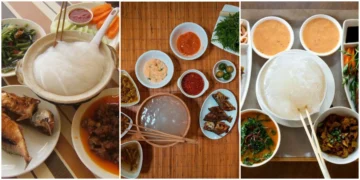The Republic of Burundi is a small landlocked country situated in the heart of Africa. It is popular for its hills, rich culture, and agriculture. Ibiharage is the best food of Burundi, which is commonly known as the Burundian bean stew. It not only serves as a source of nutrition but also embodies the spirit of harmony and community of the Burundians.
Why is Ibiharage the Best Food of Burundi?

Ibiharage, which is considered the best simply due to its pleasing taste, is so much more than a mere dish; it instantly transports the Burundians back to their childhood, reminding them of the fond memories associated with home. While family gatherings and feasts bring people together as food plays an integral part in the celebrations, Ibiharage is the dish that stands out amongst the Burundians. Most appeal is attributed to Ibiharage for being a stew made with simple yet delicious ingredients, be it anytime during the day or at functions like weddings, Ibiharage serves as the true Burundian meal. This really goes to show how much it means to their agriculture and humble nature.
For many Burundians, Ibiharage is the culinary backbone of their daily lives. It is a dish with constructed roots, where each family adds its own small twist while striving to preserve the core of the dish. The satisfying, rich taste and soft texture of the cooked beans make Ibiharage perfect as it fulfills both hunger and a level of comfort while coaxing the warmth of nostalgia.
Key Ingredients of Ibiharage
The great thing about Ibiharage is that it is incredibly simple. Regardless of its simplicity, all ingredients are carefully selected and coordinated in order to achieve a nourishing and well-balanced dish:
- Beans: The most important ingredient in Ibiharage is undeniably the beans, which are locally sourced and frequently produced. The main ingredient of the dish, and the most common type, is the kidney bean, which is very high in protein and fiber.
- Tomatoes: A fresh tomato or a dash of tomato paste is added to provide a subtle zing, as well as flavor and color to the stew.
- Onions & Garlic: Chopped onions and garlic are sautéed in order to add another layer and depth of flavor and savory to the meal, in addition to my beans. This all ensures that the food is extremely fragrant.
- Spices: The flavoring of the beans involves a light mix of salt, black pepper, and chili pepper if needed, to provide some warmth while not masking the natural essence of the beans.
- Vegetable Oil: Use a small quantity of oil for sautéing the aromatics since the oil does not allow the flavor to blend in whilst boiling.
- Optional Enhancements: A few family secrets may embellish the recipe with a sprinkle of local herbs or a splash of lemon juice to enhance brightness depending on the season and availability of goods.
Each element is meticulously selected to respect the exquisite taste of Burundian produce as it’s meant to demonstrate the beauty of the beans while giving the opportunity to enhance the flavor combination.
Prepare Ibiharage (Best Food of Burundi)

- Soaking the Beans: As a tradition, the beans are soaked in a water basin overnight. This step greatly assists in lessening the cooking time while improving the digestibility of the food. Soaking the beans is a sure way to guarantee a smooth, creamy texture and even cooking throughout.
- Cooking the Beans: The next day, the beans are soaked, drained, and placed in a large pot with fresh water. They are brought to a boil and simmered until tender. The step of slow-cooking the beans in water is an important step because it assists in breaking down their fibrous structures.
- Building the Flavor Base: In a different pan, chopped onions and garlic are sautéed in a small amount of vegetable oil. They are cooked until soft and golden. At this stage, tomatoes or tomato paste are added, and the whole mix is allowed to simmer. This creates a rich and aromatic base while spices and seasonings are added to balance the flavor.
- Combining and Simmering: The beans are cooked to a tender consistency and then combined with the sautéed aromatics. The mixture is left to meld together, allowing the stew to simmer. At this point, the sauce thickens slightly as the starch from the beans mingles with the tomato base. This results in a hearty homogenous stew.
- Finishing Preparation and Consumption: The final taste check and seasoning routine is relevant before serving ibiharage. Salt and spices tend to be adjusted based on taste preference. Lemon and freshly cut herbs tend to add a last touch to brighten the dish as well. Ibiharage is served hot on a daily basis alongside sides like ugali or maize porridge, which goes nicely with the creamy beans.
What Makes Ibiharage Unique?
The uniqueness of ibiharage can be attributed to its simplicity alongside the rich culinary culture of Burundi. Unlike other, more complex stews, ibiharage is well known for celebrating traditional cooking styles and local ingredients. It serves as a versatile foundational dish because of its ability to adjust depending on region, local ingredients, and flavors. Ibaharage is a go-to staple because of its neutral yet rich profile that works great with multiple sauces and side dishes.
Additionally, the preparation and consumption of Ibiharage is intimately connected to the customs and culture of Burundi. It’s a dish meant for sharing, whether it is eaten on a day-to-day basis or served at family functions, and helping to strengthen relationships within the society. This dish is an example of how resilient and creative Burundians are, considering its uncommon yet wholesome roots, and how effortlessly they have adapted to using natural resources available to them.
History of Ibiharage

Alongside its culinary significance, Ibiharage also tells a story of the agricultural development of the country. Beans were grown in the region for centuries and were considered a staple food because of the nutrition they offered. How the dish came to be mirrors the people’s influences and assimilations.
Ibiharage was usually regarded as sustenance food in rural areas as it is simple to prepare and economical. It soon turned into a way for families to bond with each generation, putting their spin on it. In more recent times, urban households have started using modern cooking techniques and ingredients. However, the core essence of the dish still remains a mark of the unyielding simplicity found in Burundian cooking.
Today, Ibiharage is celebrated not only for its taste but cultural importance as well. It serves as a reflection of the country’s agrarian past alongside the role of community in everyday life. Each bite symbolizes the heritage of those who worked endlessly utilizing their resourcefulness. It shows how they transformed simple beans into a nourishing meal for the body and spirit.
Other Authentic Delicacies from Burundi
Ibiharage may be the defining component in Burundian cuisine. However, the country is home to many other traditional dishes that fully encapsulate the Burundian culinary profile:
- Maboke: Traditional style of preparing fish or meat by wrapping them in banana leaves and steaming them.
- Isombe: A mouthwatering dish prepared using cassava leaves and peanut sauce that provides a unique blend of textures and tastes.
- Brochettes: Juicy chunks of meat marinated and skewered, grilled, then served with spicy dips. They are served widely in social gatherings and thus are regarded as street food.
- Ugali: Ground corn or millet-derived flour is steamed to form a dense, doughy porridge. It is served with stews that use the beans as the main ingredient, like Ibiharage.
- Akabenz: This savory pork dish is prepared with local spices and slow-cooked until tender.










Discussion about this post